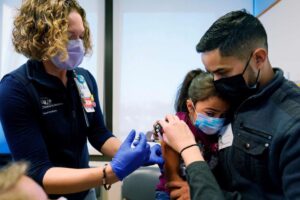JUNE 20, 2022

Kidney transplant patient Sophia Silvaamaya, 5, held by her father, Pedro, is vaccinated by nurse Kelly Vanderwende on Nov. 3, 2021, at Children’s National Hospital in Washington.- Carolyn Kaster, AP
COVID-19 vaccines for the youngest Americans will be available starting Tuesday. Though some parents can’t wait to vaccinate their young children, others remain hesitant or adamantly opposed.
In polling data from April, 18% of parents said they would vaccinate their young child right away, and 27% said they definitely wouldn’t and 38% said they’d wait and see.
The coronavirus has been less dangerous for children, especially small ones, than for older adults.
That doesn’t mean it’s harmless.
More than 200 children ages 1-4 have died from COVID-19, and 20,000 have been hospitalized with the disease.
As many as 68% of American preschoolers have been infected over the past two and a half years, missing out on social and learning opportunities and passing the virus on to parents, grandparents and caregivers.
Last week, two expert advisory panels, one for the Food and Drug Administration and the other for the Centers for Disease Control and Prevention, reviewed safety and effectiveness data on the shots.
Both panels unanimously found that the benefits of vaccination for children 6 months to 5-6 years outweigh the risks. Members of the CDC’s Advisory Committee on Immunization Practices (ACIP) were adamant Saturday that parents should take the opportunity to protect their children against COVID-19.
“I am fully confident that vaccines should be recommended,” said ACIP chair Grace Lee, a pediatrician at the Lucile Packard Children’s Hospital and professor at the Stanford University School of Medicine, both in California. “We can clearly prevent hospitalizations and deaths, and I believe we have the opportunity to prevent long-term complications of infections.”
Parents will be able to choose between vaccines from Moderna and Pfizer-BioNTech.
Healthy children ages 6 months to 6 years would get two shots of Moderna’s vaccine four to eight weeks apart. They would probably need a third dose, though the timing hasn’t been worked out.
Children ages 6 months to 5 years would get their second shot of Pfizer-BioNTech’s three-dose vaccine three to eight weeks after the first and their third shot at least eight weeks later.
Here is what you should know:
Should I vaccinate my child against COVID-19?
COVID-19 vaccines are not required for children to attend school, so it’s up to every family whether they want to vaccinate their young children.
Vaccines, data shows, reduce the small risk in this age group of developing severe disease and the even smaller risk of death from COVID-19.
If children have a preexisting health condition, such as diabetes or an autoimmune disease, they are probably at higher risk for severe disease, although about half the young children hospitalized with COVID-19 had no preexisting health problems.
Risk of serious infection increases during a major outbreak, like the wave caused by the omicron variant of the coronavirus in the early weeks of this year. Older children and teens who were vaccinated during that outbreak were less likely to suffer severe disease than their peers who weren’t vaccinated, FDA data shows.
Studies from Moderna and Pfizer-BioNTech found the vaccines safe for children under 6, who had no severe allergic reactions or swelling of the heart muscle – which are rare but potential side effects in older children and adults.
Committee members said they understand that some parents don’t think vaccines should be provided to small children.
“For those who disagree with the decision we made today, we hear you,” said ACIP committee member Dr. Matthew Daley, a senior investigator with the Institute for Health Research, Kaiser Permanente Colorado in Aurora.
“You’ve emphasized that you don’t think these vaccines are effective. We’ve shown data that show that they are,” he said.
What are the potential side effects of the vaccines?
The youngest children face essentially the same vaccine side effects as everyone else, including fever, fatigue and swelling at the injection site.
Company studies in about 8,000 young children found no new side effects compared with older children or adults. They did not see any of the rare side effects known to occur in older age groups, severe allergic reactions or myocarditis, a swelling of the heart muscle. Because these events occur in less than 1 vaccine recipient per 8,000, it is possible that they will happen as more children are vaccinated.
Are they effective?
Studies show the vaccines trigger the same level of immune response in small children as they do in older children and adults who are protected.
The shots have been effective at protecting against severe disease and death but not as protective against infection. The same is likely to be true for younger children.
Which shot is better, Moderna or Pfizer-BioNTech?
It’s not clear whether one is better than the other. No studies have compared the two vaccines directly.
It’s possible that the Moderna shot has more side effects, but it may provide protection faster than Pfizer-BioNTech’s.
The dosages and the schedule differ between the two vaccines, but even that doesn’t offer much guidance about which one to give a child.
The Moderna vaccine for children 6 months to 6 years is the same as the one given to adults and older children but at a lower dose. The government authorized two 25-microgram doses to be given three weeks apart.
Pfizer-BioNTech studied a 3-microgram dose, one-tenth of the same vaccine it gives to adults. In its clinical trial, held during the early days of the omicron outbreak, two of the low doses did not produce as much of an immune reaction in small children as higher doses did in older children and adults.
Pfizer-BioNTech added a third 3-microgram dose to provide adequate protection.
Officially, the Moderna vaccine was authorized for a two-dose primary series while Pfizer-BioNTech requires three doses. Advisers, government officials and Moderna representatives were clear that everyone needs three vaccine doses to protect against omicron and its variants.
What if my child was already infected with COVID-19?
Nearly 70% of American children have been infected with COVID-19. This provides some protection, but infection with earlier variants might not protect against current ones, CDC officials said. People infected early in the omicron wave can catch omicron variants.
Data suggests that a combination of an infection plus vaccination leads to the longest and broadest protection, Moderna Senior Vice President Dr. Jacqueline Miller told the FDA committee.
There’s no specific recommendation for how long a child should wait after infection before starting vaccination, but CDC officials said that because infection provides some protection, a child could safely wait three months after infection before getting vaccinated and that the delay might improve the vaccine’s effectiveness.
Will my child need a booster shot?
Both the Moderna and Pfizer-BioNTech vaccines are likely to require three doses to provide adequate protection against omicron variants.
As with adults, it is likely children will need additional shots to remain protected against severe COVID-19 – but it’s not clear how many or how often boosters will be needed.
Does vaccination prevent ‘long COVID’?
Children, like adults, can suffer symptoms for months after a COVID-19 infection, though the syndrome is less common among children.
Vaccination doesn’t prevent “long COVID,” but it does seem to substantially decrease the risk of lingering symptoms.
What about babies younger than 6 months?
Children that young haven’t been given vaccines, because they get protection when their parent is vaccinated during pregnancy.
Studies have found the vaccines to be safe during pregnancy; a COVID-19 infection can be quite dangerous.
How does COVID-19 compare with other childhood diseases we vaccinate against?
COVID-19 causes about the same level of or more severe illness than other diseases against which children are routinely vaccinated.
Before a vaccine was introduced for chickenpox in 1993 and pneumonia in 1998, each disease led to about 40 hospitalizations per 100,000 children from birth through age 4. In 2020, hospitalization rates for COVID-19 were about 30 per 100,000 young children, and last year they were 89 per 100,000.
The number of childhood infections and deaths from COVID-19 exceed a bad season of the flu, noted FDA committee member Arthur Reingold, an epidemiologist at the University of California, Berkeley, School of Public Health.
Why did it take so long for vaccines to be authorized in young children?
The first adults were vaccinated against COVID-19 in December 2020, but children ages 5-11 weren’t vaccinated until late last year, and the youngest children are gaining access now.
Vaccines and medications are usually tested in a step-down fashion: healthy adults first, then teens, then younger children. This is to better understand the vaccine or treatment before giving it to those who are the most vulnerable and to understand the most appropriate dose for small children.
Why are the vaccines authorized only for ’emergency use’ in young children?
Following the pattern it used with adults and teens, the FDA authorized vaccines for the smallest children “for emergency use.” This is a procedure used to get products to market faster.
Companies are required to provide only two months of safety and effectiveness data under emergency use authorization, compared with six months under a full license. They have to meet more extensive production requirements for a full license.
The Moderna and Pfizer-BioNTech vaccines met those standards for adults and received a full license. In the coming months, they are both likely to apply for full licensure for younger children.
If my child is uncomfortable or feverish after vaccination, is it OK for me to give a pain reliever?
“Absolutely, yes,” Dr. Sara Oliver of the CDC told the ACIP committee. “Any time the child has symptoms after vaccine, an age-appropriate dose of whatever pain reliever of choice is absolutely encouraged.”
Parents should avoid giving children pain relievers in anticipation of side effects, said Grant Paulsen, an infectious disease pediatrician and lead researcher for the under-5 vaccine trials at Cincinnati Children’s Hospital Medical Center.
The CDC and the World Health Organization recommend against preventive use of pain relievers in adults, though they allow them if symptoms develop.
Can I get my child a COVID-19 vaccine along with other scheduled shots?
Researchers have not studied giving COVID-19 vaccines along with regular shots. Those studies will happen in coming months, company officials promised the FDA.
My child is 4. Should I wait for another birthday before vaccinating to get the higher dose?
Health experts advise getting vaccinated sooner rather than waiting.
“I don’t want people to base their decisions on where they might be a month from now. I think people should get protected now,” said Shaquita Bell, a pediatrician at Seattle Children’s Hospital, who is not a committee member.
During the trials, children who turned 5 were given a higher dose for any subsequent shots after their birthday. The dose is based on age, not weight, so a parent whose child is small or large for his age shouldn’t look for a higher or lower dose based on size.
Are vaccines effective in kids with immunocompromising conditions?
The CDC recommends that children with immunocompromising conditions, such as transplant recipients, get three doses of Moderna as their primary series, instead of the two recommended for healthy children. It’s not clear whether they will need more than three doses of Pfizer-BioNTech.
Children who are immunocompromised should get their first two shots of Moderna a month apart and their third dose at least four weeks later.
Children should get their first two shots of Pfizer-BioNTech three weeks apart, the shorter end of the recommended window, and a third shot at least eight weeks later.










































































































